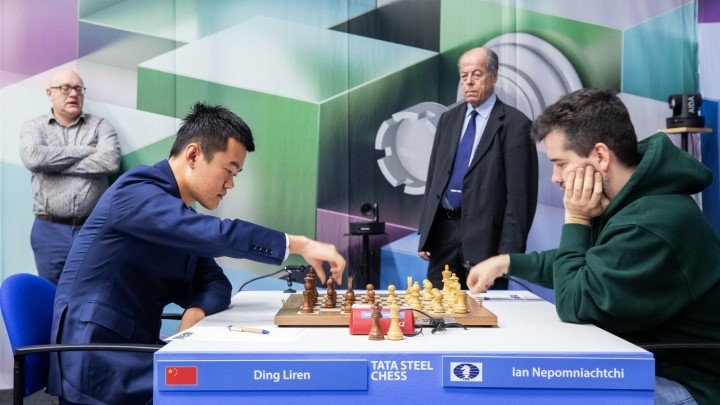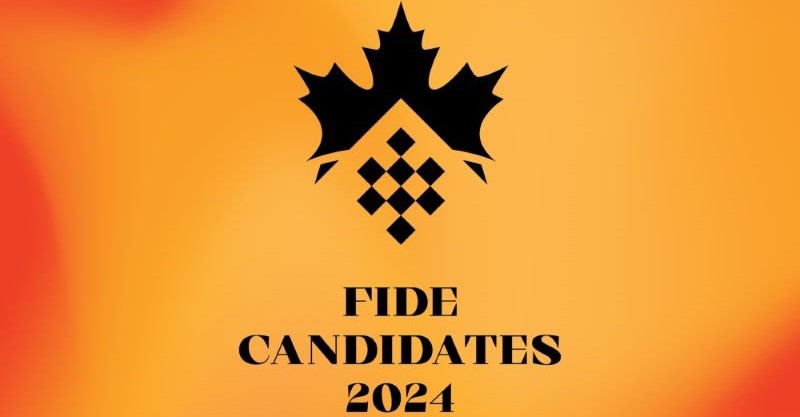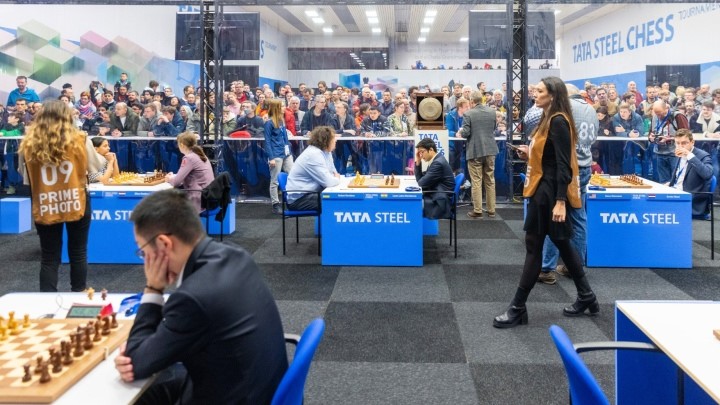Changes to qualification paths for the Candidates Tournament

FIDE has introduced a series of changes to the qualification paths that will be in effect for the FIDE Candidates Tournament in 2026. Most notably, the runner-up from the World Championship match no longer automatically qualifies for the Candidates The alterations are aimed at enhancing the competitive landscape, encouraging player participation, and ensuring a fair representation of the top contenders. The amendments will impact the selection process through various paths. The key changes and the renewed qualification paths for the Candidates Tournament 2026 are the following: World Championship Runner-Up – no spot The runner-up in the World Championship will no longer automatically get a spot in the next Candidates Tournament. Instead, the runner-up will now need to navigate the qualification process. To compensate for this change, World Championship Match 2024 is also recognized as an eligible tournament for FIDE Circuit and the runner-up will receive special bonus points for playing the match. The points they gain in the match for the World Championship title will be calculated based on performance. This means the points gained for the FIDE Circuit will depend on the score of the match. If the match is lost on tie-breaks, the runner-up will get more points than when they lose in the standard part of the match with rounds to spare. The highest-rated player – 1 spot The spot reserved for the highest-rated player will now be determined by the six-month average rating, not the previous 12 months or the current rating. This spot is exclusive to the player ranked first in the FIDE rating list. If the player withdraws, the qualification spot shall be awarded to the second-highest rated player. If the second-highest rated player has already qualified, the qualification spot will be redirected to FIDE Circuit 2025 path. Notably, the six-month average rating rule eliminates the possibility of players relying on a “last chance” tournament in December of the year in the run-up to the Candidates. FIDE Circuit – 2 spots Two spots in the FIDE Circuit – for the years 2024 and 2025 – will serve as qualifying paths for the 2026 Candidates. The final score will be the sum of a player’s highest event scores, but not more than seven event scores. For reference, the score calculation for Circuit 2024 was based on five event scores. Other main changes in FIDE Circuit rules: 1) for round-robin tournaments points are given to the top three places only, 2) a new bonus for sole 1st place without any tie-break criteria is added, 3) an unlimited number of tournaments in one country is allowed, in case the average rating of top eight players of each event is 2650 or higher. Organizers of events taking place after July 1st, 2024, must notify FIDE GSC at least three months in advance. FIDE World Cup – 3 spots The FIDE World Cup 2025 will provide three qualifying spots for players who finish 1st, 2nd and 3rd. FIDE Grand Swiss Tournament – 2 spots The FIDE Grand Swiss Tournament will offer two qualifying spots for the Candidates Tournament, for the players who finish 1st and 2nd. This table highlights the difference between the existing and new qualification system for the Candidates: FIDE Candidates Tournament 2026 will witness eight players qualifying through distinct paths, emphasizing diversity and fairness, ensuring a competitive and merit-based selection process. “These changes have been carefully thought through, considering all important factors, with the aim of making the qualification process more engaging and fairer. This reflects FIDE’s commitment to evolving and refining the qualification process, promoting a dynamic and competitive chess environment,” FIDE President Arkady Dvorkovich said. As the chess community eagerly awaits the Candidates Tournament in Toronto, these alterations for the 2026 event are poised to shape a new era in the journey towards determining the World Chess Champion. Related documents: Regulations for FIDE Circuits 2024 Regulations for FIDE Circuits 2025 FIDE Candidates Tournament 2026: Qualification paths
Tata Steel Masters 2024: Abdusattorov forges into the lead

Nodirbek Abusattorov scored a crucial victory over Ju Wenjun in Round 11 of Tata Steel Masters and grabbed the lead. Gukesh D had a chance to keep up with the Uzbek GM but missed a couple of chances in the game with Alireza Firouzja and had to settle for a draw. Wei Yi and Vidit Gujrathi pulled off wins against Max Warmerdam and Parham Maghsoodloo, respectively, and joined Praggnanadhaa R and Giri, trailing the leader by a full point. Nodirbek Abdusattorov – Ju Venjun | 1-0, 34 moves In Giocco Piano Nodirbek surprised the Women’s World Champion with unusual 7.c4!? blocking his light-squared bishop and it worked out for him as instead of natural 8…Bg4 (a typical move in such positions) Ju carried out somewhat sluggish maneuvers with her knight. White expanded on the queenside and, after taking control over the a-file, delivered a nice blow. 23. Nxf7! Kxf7 At this point, the opponents traded serious mistakes, but Ju made the last one. 24. Qa2?! (24. dxe4 Rd8 25. Nd5 Qc6 26. Qe2 Ke8 27. Nxf6+ Bxf6 28. Bxe6 Qxe6 29. Rxb7 was much stronger, but it was not easy to calculate all the lines). Here, in the case of 24… Rd8! 25. Bxe6+ Kf8 26. Bd5 Nxd5 27. Nxd5 Bxd5 28. Qxd5 Rxd5 29. Rxc7 exd3 30. Bd2 Rd4 White has to work for a draw. The Women’s World Champion, however, played 24…Qc6? and after 25. Rxb7 Qxb7 26. Bxe6+ Ke8 27. dxe4 Qxe4 28. Nd5 Bd8 29. h3! Black had no arguments against the coordinated attack of White’s pieces. Nodirbek conducted the final portion of the game in a clinical fashion and scored a full point. Parham Maghsoodloo – Vidit Gujrathi | 0-1, 37 moves The game saw a sharp tactical melee in the QGD, from which White emerged with an extra pawn, but his king got stuck in the center. Unluckily for Parham, choosing between aggressive and more solid continuations, he stayed true to himself and went for an active but erroneous move. Instead of 20. Be3 with a slightly better position, the Iranian played 20.Bxh6? but it failed to 20…Qxc5! 21. Rxf6 Qe7! 22. Bxg7 Kxg7 23. Rf5 Rd8 24. h4 (better was 24. g3 Bxf5 25. Qxf5 Rac8) 24… Bxf5 25. Qxf5 Rd4 and Black won an exchange. The rest was a smooth sail for Vidit, who swiftly converted his material advantage. Ding Liren – Jorden Van Foreest | ½-½, 25 moves The game saw a popular line of English Opening in which Black sacrifices a pawn and trades the queens but builds a defensive line on dark squares. On move sixteen, Ding could have undertaken some activity in the center, but he preferred a more reserved approach. After some maneuvering in an equal position, a draw by repetition was agreed on move 25. Gukesh D – Firouzja | ½-½, 38 moves Alireza achieved a promising position on the black side of the Gruenfeld and put pressure on White’s d5-pawn. Gukesh, in his turn, sacrificed it but pushed f4-f5 and got sufficient compensation in the form of weakening the opponent’s kingside. Just a couple of moves down the road, the opponents reached the critical position of the entire game. Here after 25…Nd5-f4? White had a very strong queen sacrifice 26.Rxd7! and after 26. Rxd7 Nxe6 27. fxe6 Black is doomed to an uphill battle with little chance of escape. Gukesh preferred to trade his queen for two rooks with 26.Qxd7 and got an edge anyway as Alireza erred with the very next move. However, on move 31, the young Indian missed another chance to obtain a considerable advantage, and the game ended in a draw by repetition. Praggnanandhaa R – Alexander Doncheko | ½-½, 56 moves Praggnanandhaa had an initiative throughout the game that saw the QGA, but his advantage never became decisive as Alexander found the best defensive moves at critical moments. White eventually won a pawn, but it was just another case of “all rook endgames are drawn” as Black comfortably held a draw. Wei Yi – Max Warmerdam | 1-0, 27 moves The most exciting game of the round started as the Bishop Opening, but after White played f2-f4 early on, it quickly took shape the King’s Gambit. The opponents played the most principled moves, with White sacrificing a rook and Black accepting the challenge, but the evaluation of an erratic position surprisingly hovered about equal. Both demonstrated precise calculation up to a certain point, but Max’s first mistake became fatal. Black could have maintained equality with the precise 16… a5 17. Bxf8 Rxf8 18. Kb1 Qf6 19. d4 b5 20. Bd3 Bxf3 21. gxf3 Qxd6. Warmerdam, however, played 16…Bxf3? and after 17. gxf3 Ne5 18. Kb1 Qd4 19. Rxh1 Nxc4 20. dxc4 Qb6+ 21. Kc1 Rxf7 22. Rd1 Rff8 23. d7 White’s d-passer decided the game in his favor. Amish Giri – Ian Nepomniachtchi | ½-½, 54 moves Ian equalized on the black side of the Dutch-Peruvian Gambit (a variation of the QGD), but his decision to keep more minor pieces on the board backfired as Anish gradually turned a slight edge into a sizable advantage. However, at the game’s turning point, Giri was tempted by snatching a pawn but underestimated Black’s counterplay. After 26. Rce1 Rxe5 27. Rxe5 Qc6 28. Qb3 Kf8 29. h4 White could have exerted long-lasting pressure, with Black being doomed to passive defence. Anish captured the d-pawn with 26.Rxd5, but after 26… Bc6 27. Re1 Rcc8 28. Rde5 Rxe5 29. dxe5 Qe6 Ian got a serious counterplay against White’s weak pawns. Giri quickly realized that the tide had changed and soon offered a draw, which was accepted. Masters pairings Photos: Jurriaan Hoefsmit – Tata Steel Chess Tournament 2024 Official website: tatasteelchess.com
Announcing winners of FIDE Trainer Awards 2023

The FIDE Trainers Commission is pleased to announce the winners of the 15th FIDE Trainer Awards 2023, which recognize and celebrate the achievements of the chess training community and the best chess books of the year 2022. Ramesh R B (IND)Mikhail Botvinnik Award 2023 Ramesh R B (IND) wins the Mikhail Botvinnik Award for the best achievement in Open Section competitions. Over the last few years has worked with many Indian chess stars, including Rameshbabu Praggnanandhaa; the winner of Dubai Open 2022, Aravindh Chithambaram; Rameshbabu Vaishali and the bronze winner in the World Women’s Rapid Championship and Savitha Sree. Ramesh R B also captained Indian Team B, which earned bronze at the 2022 Chess Olympiad. Abhijit Kunte (IND)Vakhtang Karseladze Award 2023 India’s fourth GM, Abhijit Kunte (IND) receives the Vakhtang Karseladze Award for the best achievement by a trainer in women’s and/or girl’s competitions. Serving as non-playing captain and coach, he led the Indian Women’s Team to silver in the World Women’s Team Championship (2021) and Asian Games (2022) and to bronze at the 44th Chess Olympiad. Djakhangir Agaragimov (AZE)Mark Dvoretsky Award 2023 Djakhangir Agaragimov (AZE) has been chosen by the judges for the Mark Dvoretsky Award for the best achievement by a trainer in junior events. Over many years of coaching, Djakhangir raised several GMs, WGMs, and IMs. His pupils became winners and medalists of European Championships in different age groups. In 2022, his student GM Abdulla Gadimbayli won the World Junior U20 Championship title. The Yuri Averbakh/Isaac Boleslavsky Award for the best book published in 2022 goes to “Rock Solid Chess: Tiviakov’s Unbeatable Strategies: Pawn Structures“, co-authored by Sergei Tiviakov and Yulia Gokbulut and published by New In Chess. In his first book, Sergei Tiviakov explains everything he knows about the fundament of chess strategy: pawn structures. Famous for deep chess knowledge and rock-solid positional play the Dutch GM has gathered a rich collection of strategic lessons he has been teaching worldwide, drawing mainly from his personal experience. The examples and exercises suit any reader from club player to grandmaster level. The runners-up were “The Exchange Sacrifice According to Tigran Petrosian” by Vassilios Kotronias, published by Russell Enterprises, Inc. and “Learn from Bent Larsen” by Mihail Marin, published by Quality Chess. These were the panels for Trainer Awards and Book Award respectively: Trainer Awards Jury Panel FST & GM Le Quang Liem (VIE)FST & GM Vladimir Akopian (USA)FT & GM Bassem Amin (EGY)FT & GM Mihail Marin (ROM) Book Awards Jury Panel FST & GM Antoaneta Stefanova (BUL)FST & GM Rustam Kasimdzhanov (UZB)FST & GM Emil Sutovsky (ISR) The winners of the FIDE Trainer Awards will be invited by TRG to be awarded during one of the major FIDE events.
Tata Steel Masters 2024: Gukesh and Abdusattorov forge ahead

Gukesh D defeated Alexander Donchenko with the black pieces in Round 10 of Tata Steel Masters 2024 and grabbed the lead. Closer to the end of the day, Nodirbek Abdusattorov joined the Indian on the top after prevailing over Max Warmerdam in a long, topsy-turvy game. Praggnanandhaa and Giri drew with Black against Vidit and Firouzja respectively, while Ian Nepominachtchi reached the +1 mark after beating his old rival and the current World Champion Ding Liren. Gukesh and Abusattorov are going to the last rest day as the joint leaders on 6.5/10 with Praggnanandhaa and Giri trailing by a half point. Alexander Donchenko – Gukesh D | 0-1, 57 moves Playing on the white side of the Rubinstein Nimzo-Indian, Alexander Donchenko used the idea of his namesake Alexander Predke 12.h4, introduced at the end of 2021. Gukesh reaction to Kd7-b6-c4 to this plan was somewhat sluggish, and by advancing his kingside pawns, White grabbed the initiative. However, at this point, it was Alexander’s turn to err. In case of natural 15. O-O-O cxd4 16. Nxd4 White is clearly better, but Alexander played a tempting but overambitious 15.d5, which was a serious mistake as after 15… Rb8 16. h5 b5 17. g5 Nd7 18. f4 Bf8 19. h6 g6 Black was ready to attack the opponent’s overstretched position. The players traded inaccuracies over the next several moves, but Alexander’s 22.Ne4, followed by Ng3, was the last straw. Most likely, he missed a temporary exchange sacrifice 23…Rxe4! and after 24. Nxe4 Qe7 25. Nf6+ Qxf6 26. e4 Qd4+ 27. Kf3 Qxd5 Black got an overwhelming position. Gukesh’s conversion was far from ideal, but he eventually came out victorious. Max Warmerdam – Nodirbek Abdusattorov | 0-1, 71 moves The opponents “joined efforts” and created a very complex position out of the QGA in which Black gradually took control over the proceedings and struck on the kingside with a powerful 24…f4! After 25. exf4 Nd3 26. Rc3 Nxb2 27. Qd2 Nxa4 28. bxa4 Bb4 29. g4 Nxg4 30. hxg4 Bxg4 31. Ng3 Nodirbek could have obtained a sizable advantage with 31…Qh6 whereas 31…Bf5, played by the Uzbek GM, turned the tables. After 32. Qe3 Bxc3 33. Nxc3 Bc2 34. Nce4 Bxe4 White could have got the better hand with 35.Bxe4, whereas 35. Nxe4, played by Max, lead to an equal position again. At this point, the game took a new twist as Abdusttorov made several questionable moves and found himself on the verge of defeat. Here, Max had three squares for the knight to retreat, followed by advancing his a-passer, and he chose the wrong one. After 42. Nc7 Rxf4 43. Qe5 Rfxd4 44. a6 Rd1 45. a7 Rd8 46. a8=Q, his a-pawn would have cost Black a rook. The Dutchman snatched the b-pawn with 42.Nxb4!? and after 42…Rxf4 committed a more serious error 43.Qb1? (instead of 43.Qe5) Rdxd4 43.Nd3 (43.Nxc6 fails to 43…Rxf2+!). According to chess engines, the position is in balance, but White should proceed with caution. After protracted maneuvering, White overextended his defensive line and sent the king to the queenside, but the position remained roughly equal up to move 67 when Warmerdam cracked. After 67.Qd5, chess engines show =, but Max played 67.Bc4?? Nodirbek did not miss an opportunity to pounce on White’s king and after 67…Qf6+ 68. Ka3 (68. Kc2 Rxf2+ 69. Nxf2 Qxf2+ 70. Re2 Rxe2+ 71. Bxe2 Qxe2+) 68… Ra1+ 69. Kb4 Rb8+ 70. Bb5 Qd4+ 71. Qc4 Rb1+ Max resigned, facing an imminent checkmate. Ian Nepomniachtchi – Ding Liren | 1-0, 36 moves Despite opting for a calm line of Ruy Lopez, Ian manifested his aggressive intentions with early g2-g4 followed by opening the g-file for his rooks. The World Champion confidently held his ground, but a dubious rook maneuver at the critical point cost him the game. Two moves ago, Black played 29…Rb6. Here, instead of 29…Qd5, which offered many defensive options, Ding retreated his rook with 31…Rb8? and after 32. Qc5! Rd8 33. Ne4 Qe6 34. Rh4 Rd5 35. Qa3 g6 36. Nfg5, the Chinese GM resigned, being unable to dodge numerous threats. Ju Wenjun – Parham Maghsoodloo | ½-½, 54 moves Parham comfortably equalized with Black in the Vienna Variation of QGA but somewhat prematurely advanced his central pawns and ended up down a pawn. Still, Black had some compensation, and after a couple of inaccuracies by the Women’s World Champion, Maghsoodloo held a draw in a rook and knight endgame. Vidit Gujrathi – Praggnanandhaa R | ½-½, 37 moves Another Indian derby saw a popular line of the Bogo-Indian in which Vidit made a new move 13.Rab1, but then played the thematic c4-c5 anyway. White had a slight advantage, but after massive exchanges and mutual annihilation of pawn weakness, the opponents called it a day in a dead-drawn minor piece endgame. Alireza Firouzja – Anish Giri | ½-½, 51 moves In the reversed QGA, the players quickly stepped onto uncharted territory, but the subsequent play revolved around Black’s isolated pawn, which is a recurrent theme in such positions. Trying to create one more weakness in Black’s camp, Alireza advanced his kingside pawns and sacrificed a pawn, but Anish timely returned the gift to activate his pieces. After trading the rooks and removing all the pawns, the players agreed upon a draw on move 51. Jorden Van Foreest – Wei Yi | ½-½, 36 moves The opponents tested a rare line of Trompovsky and followed the recent game Nakamura – Caruana (2023) up to move 16. Jorden deviated with 16.Rb1, but just like Hikaru, did not achieve much. In the subsequent play, White sent his queen to the kingside, while Black infiltrated the opposite wing with his strongest piece and advanced his central pawns. After a tactical melee, the players went for a forced line in which Jorden won a pawn, but Wei was just in time to activate his heavy pieces and deliver perpetual. Masters pairings Photos: Jurriaan Hoefsmit and Lennart Ootes – Tata Steel Chess Tournament 2024 Official website: tatasteelchess.com
FIDE Trainers Online Seminar 2024 announced

Organized by the Asian Chess Federation in cooperation with FIDE Commission for Women in Chess under supervision of FIDE Trainers’ Commission, FIDE Trainers’ Online Seminar will be held from February 2-4, 2024. Seminar program and schedule: Contact: FIDE Trainers’ Commission trainers@fide.com Venue: Zoom Participation fee: 200 Euros Lecturers: GM Artur Jussupow GM Hou Yifan GM Iossif Dorfman GM Antoaneta Stefanova GM Alexander Moiseenko GM Igor Lysyj Seminar language: English Rules and regulations: trainers.fide.com/trg-online-seminars/ FIDE commission for women’s chess covers 20 places for female participants. Registration is open for women based on first come first served condition with focus on representatives from different continents. Registration link: forms.gle/pwDJNPT89CH8EPcC6 In case of possible questions please contact WOM representative Yilmaz Kartal Email: yilmazkartal@gmail.comWhatsApp: +90 542 606 67 29
Tata Steel Masters: Four in the lead after Round 9

Round 9 of the Tata Steel Masters 2024, played in Hague, has been the most exciting so far, producing five victories (all five by White) and just two draws. After Nodirbek Abdusattorov bested Jorden Van Foreest and Praggnanandrhaa outplayed Ju Wenjun, both joined Anish Giri and Gukesh D in the lead. Alexander Donchenko and Parham Maghsoodloo notched up their first wins in the event, defeating Alireza Firouzja and Max Warmerdam, respectively. Wei Yi outbattled Ian Nepomiachtchi and caught up with Vidit and Firouzja. Ding Liren – Anish Giri | ½-½, 34 moves The opponents followed the game Jobava – Oparin (2022) in the QGD Carlsbad, with Anish deviating first on move 14. His novelty 14…Ndf6 worked well as Black reached a very comfortable position while White had to keep an eye on his kingside weaknesses. However, instead of increasing pressure with 32…Rh8 Anish decided to call it a day by forcing a draw by repetition. Nodirbek Abdusattorov – Jorden Van Foreest | 1-0, 24 moves In the Bishop Opening, Jorden reacted poorly to the reserved 8.Bb3 by Abdusattorov and by move 12 got in a very tough situation. Visually upset, the Dutchman did not manage to pull himself together and admitted his defeat in a strategically hopeless position with almost all the pieces remaining on the board. Praggnanandhaa R – Ju Wenjun | 1-0, 33 moves The young Indian introduced a novelty 10.b3 in a topical line of the Two Knights in which Black sacrifices a pawn, but the Women’s World Champion got sufficient compensation. However, six moves later, she did not trade the light-squared bishops and allowed her opponent to consolidate. After 16… Bxa6 17. Qxa6 Ng4 Black’s initiative counterweights White’s extra pawn, whereas after 16…Be6 17. Nc4 Bb4 18. O-O-O played in the game, Pragg emerged clearly better. Ju still had some chances for a stubborn resistance, but on move 22, she made a fatal error opening the g-file, and White’s crushing attack decided the game in his favour. Alexander Donchenko – Alireza Firouzja | ½-½, 35 moves In a popular line of the Ragozin, Alireza advanced his kingside pawns and obtained a superior position after a short collision in the center. Alexander tried to trade Black’s most active piece and surprisingly succeeded. After 21… Bf8 22. Nc3 Qb6 23. Na4 Qc7 Black could have gradually built up pressure, whereas White had no active plan. Alireza, however, played 21…Rc8 and after 22. Nxd6 Qxd6 23. Kf1 Qb6 24. Rb1 Bd7 25. Kg1 Rce8 26. Qf4 the position became equal. A few moves later, Firouzja allowed White’s bishop to penetrate to f5 and found himself in real danger. After White snatched the g4-pawn, Black still had some counterchances, but his 33rd move became fatal for him. Instead of 33…Qe6 that offered some hope, Alireza played 33…Rh6? and capitulated after 34. Rc7 Rh7 35. Bxh5 1-0 Wei Yi – Ian Nepomniachtchi | 1-0, 41 moves Fully aware of Ian’s excellent preparation in the Petroff, Wei essayed the Bishop opening, which proved to be the right choice. On move 15 the Chinese GM introduced a strong novelty 15.d4 and got a slight edge. Still, Black had a playable position, but after White chipped away in the center with 21.f3, Ian erroneously backed away from the queen exchange. After 22…Qxf3 23. Nxf3 Kf8 Black had a chance to equalize, although it was not that easy. Ian decided to keep the queens on the board with 22…Qg5? but after 23. Nc4! h5 24. d6! Kf8 25. Re7! Rxe7 26. dxe7+ Kxe7 27. Re1+ Kf8 28. Nd6 Qd2 29. Qc3 Qxc3 30. bxc3 White liquidated into a won endgame in which Wei demonstrated excellent technique. As soon as White’s king penetrated Black’s camp, Ian threw in the towel. Parham Maghsoodloo – Max Warmerdam | 1-0, 57 moves Once again, Max played the gambit line of the Tarrasch that had tested against Gukesh in Round 7 and got some compensation. Moreover, after Parham’s dubious knight manoeuvre, the Dutchman won an exchange. After 16. Qe4 Qxe4 17. Nxe4 f5 18. Ng3 Nc2+ 19. Ke2 Nxa1 20. Bd2 Bg7 21. Rxa1 f4 22. Nf5 Bxb2 Black obtained the decisive advantage. In subsequent play, Black returned an exchange but got two passers on the queenside. As soon as these pawns set in motion, many thought that White’s days were numbered. At this point, Parham went all out by grabbing the f7-pawn and pushing his e-pawn, although the opponent’s pawns were advancing much faster. Here, Black was winning with 51… Ba3 52. e7 Bxe7 53. Nxe7 Ra3 54. Rc1 a1=Q. Unfortunately for Max, he completely misplayed this position with 51. e6 Ra3 52. Rxc5 a1=Q 53. e7, and it turned out that despite Black’s extra queen, he had no win. Dismayed by this turn of events, the Dutchman made a fatal error, missing even a draw. After 53…Qh8?? (instead of 53…Qb1+ or 53…Qf1) 54. Rc8! Qh7+ 55. f5 Rg3 56. e8=Q Rxg4+ 57. Ke5 Warmerdam capitulated. Gukesh D – Vidit Gujrathi | ½-½, 31 moves The Indian derby saw a popular line of the Petroff Defence tested on many occasions. After the players traded all the rooks in a nearly symmetrical equal position, a draw was agreed upon on move 31. Masters pairings Photos: Jurriaan Hoefsmit – Tata Steel Chess Tournament 2024 Official website: tatasteelchess.com
World Championships 2025 Call for Bids ends in 10 days

FIDE Events Commission would like to remind all National Federations that the procedure “Call for Bids FIDE World Championships 2025” will be completed on February 1, 2024 at 15.00 CET. Please submit your bids before the official deadline. There are 12 competitions: World Cadet U8, U10, U12 Championships World Youth U14, U16, U18 Championships World Junior U20 Chess Championships World School Chess Championships U7, U9, U11, U13, U15, U17 World Cup U8, U10, U12 World Cadet & Youth Rapid & Blitz Chess Championships World Youth U16 Olympiad World Schools Team Chess Championships World Senior Chess Championships (50+, 65+ Individual) World Senior Team Chess Championships (50+, 65+) World Amateur Chess Championships World Disabled Chess Championships Dear bidders, you can find more details about the procedure including the Bid Form and Bid Form Annex, Bid and Deposit Fees HERE.
FIDE and World Chess launch Women’s Wednesday Online Tournament Series

January 23, 2024, Lausanne, SWITZERLAND — In a groundbreaking move to elevate women’s participation and recognition in the world of chess, the International Chess Federation (FIDE) and World Chess are thrilled to announce the launch of the Women’s Wednesday Online Tournament Series “Swiss Queens Wednesday”. This weekly event, hosted on the FIDE Online Arena platform (chessarena.com), represents a significant stride in empowering women within the chess community. Empowering Women in Chess: A Step Towards Inclusion and Diversity As part of the FIDE 100th anniversary, it is fitting to launch a women’s tournament to fully celebrate the achievements of women in chess and mark 100 years as a pivotal moment in the sport. At the core of this initiative is a commitment to promoting gender diversity and providing a global stage for women to showcase their chess skills. This series is more than just a competition; it is a vibrant community where female chess players can connect and grow together in both personal and professional realms. Innovative Online Format Meets High-Stakes Competition The “Swiss Queens Wednesday” leverages state-of-the-art technology for fair play monitoring and global participation, making it a pioneering event in the chess world. FIDE Online Arena is proud to be the digital venue for this series, offering a seamless and sophisticated online chess experience. Swiss Queens Wednesday Tournament: Details and Regulations The “Swiss Queens Wednesday” takes place every Wednesday on the FIDE Online Arena (chessarena.com/tournaments/the-swiss-queens-wednesday-1), starting from January 31st at 17:00 Central European Time. The tournaments are open to all women chess players who hold FIDE or FIDE Online Arena titles and feature a Swiss pairing system with a 3+1 Blitz time control. Prizes totaling 1,000 USD per tournament will be awarded, with a potential annual prize fund increase to $100,000. The tournament emphasizes fair play, with strict adherence to FIDE’s regulations and innovative anti-cheating measures. Commitment to Fairness and Integrity Participants are expected to uphold the highest standards of sportsmanship. The Night Watch Fair Play Suite will analyze games, and players are required to join a monitored Zoom meeting during the tournament. Building a Legacy for Women in Chess This tournament series is more than just a competition. It’s a statement of FIDE’s unwavering dedication to empowering women in chess, not only on the board but also in leadership roles and personal development. It’s an opportunity for women to challenge stereotypes, inspire future generations, and demonstrate their strategic prowess on a global stage. For female chess players, the tournament not only serves as a platform to refine their strategic prowess but also to enhance their showmanship abilities, with a strong encouragement for game streaming. Dana Reizniece-Ozola, FIDE Managing Director, stated, “The Women’s Wednesday Online Tournament Series marks a significant milestone in FIDE’s ongoing commitment to gender equality in chess. This series isn’t just about playing a game; it’s about empowering women to take center stage in an arena they have long been a part of. We encourage participants to stream their games, showcasing not just their chess skills but also their unique personalities and perspectives. This is more than a tournament – it’s a movement towards a more inclusive and dynamic chess community.” Ilya Merenzon, CEO of World Chess: “As we unveil the Women’s Wednesday Online Tournament Series, we’re not just setting up chess boards; we’re building a community. This initiative goes beyond the game. It’s about giving a voice and a stage to women in chess, encouraging them to showcase not only their strategic acumen but also their personalities and stories through streaming. I hope that every move will inspire someone watching. I am also looking forward to working with female athletes to collectively enhance chessarena.com, making it their preferred permanent home for online chess.” About FIDE and World Chess FIDE, the governing body of chess, is committed to promoting chess globally and fostering a diverse and inclusive chess community. World Chess (LSE:CHSS), FIDE commercial partner, is proud to work with FIDE in hosting this groundbreaking series on chessarena.com, FIDE’s official gaming platform. For more information, please visit chessarena.com: chessarena.com/tournaments/the-swiss-queens-wednesday-1
History of the Candidates: from Budapest (1950) to Toronto (2024)

The Candidates Tournament, the final test that a player must pass to challenge the World Champion in chess, has a rich history dating back to 1950. This event emerged as a response to the need for a systematic approach to determine a world championship challenger. Prior to 1950, contenders had to navigate a maze of negotiations directly with the champion, secure funding, and organise a match – a process that lacked structure and consistency. The turning point came in 1950 when Budapest hosted the inaugural Candidates Tournament, a 10-player double round-robin to select the Challenger for the then World Champion, Mikhail Botvinnik. This tradition, set in Budapest, continued almost every third year until 1993, alternating between tournaments and matches. However, the early 1990s saw a disruption due to the split in the world championship structure. The Candidates Tournament returned to prominence in 2007 as part of the unified cycle, initially in the form of matches. The modern-day era has witnessed notable tournaments in London 2013, Khanty-Mansiysk 2014, Moscow 2016, Berlin 2018, Yekaterinburg 2020-21 and Madrid in 2022, each contributing to the glorious history of the championship qualification process. Toronto is the next chapter in this great story of chess. The Inaugural Tournament in Budapest (1950) The inaugural Candidates Tournament was held in Budapest from April 11 to May 18, 1950. It was a double round-robin with ten contenders—Bronstein, Boleslavsky, Smyslov, Keres, Najdorf, Kotov, Stahlberg, Lilienthal, Szabo, and Flohr. The event in Budapest became the only Candidates Tournament to end in a tie for first place with no tiebreaker in place. Bronstein and Boleslavsky had to play a playoff match held in Moscow in the summer of 1950. It ended in another tie, but Bronstein won the first decisive game and became the official Challenger. He drew a match with Botvinnik, who retained his title, as an equal score favoured the champion at the time. The Memorable Second Candidates (1953) The second Candidates stands out as one of the most famous chess tournaments ever, thanks to the timeless popularity of excellent tournament books by participants David Bronstein and Miguel Najdorf. The tournament was a massive affair – a double round-robin with 15 contestants, meaning each participant played 28 games. The superb lineup contributed to the rich chess heritage of this event: Smyslov, Bronstein, Keres, Reshevsky, Petrosian, Geller, Najdorf, Kotov, Taimanov, Averbakh, Boleslavsky, Szabo, Gligoric, Euwe, Stahlberg (named in order of final standings). The clear winner, Vasily Smyslov, went on to draw his first match with Botvinnik, who, therefore, retained the title. Amsterdam 1956 and the Success of Vasily Smyslov Photo: GaHetNa (Nationaal Archief NL) The 1956 Candidates Tournament in Amsterdam showcased the remarkable success of Vasily Smyslov, who secured victory for the second consecutive time. Finishing 1.5 points above the field of 10 players, he lost only one game – to 19-year-old debutant Boris Spassky. Having reached his prime form, the next year, Smyslov beat Botvinnik 12½-9½ in the match for the title and became the 7th World Chess Champion. Yugoslavia 1959 – A Chess Odyssey After winning the rematch against Smyslov 12½–10½ in 1958, Botvinnik was again the World Champion and awaited a new Challenger. In 1959, Yugoslavia hosted the Candidates Tournament, narrowing down to eight participants. In a quadruple round-robin, meaning each player meeting every opponent four times, 28 games were played in total. Three cities in Yugoslavia hosted the event, with the first half played in Bled and then moving to Zagreb and finally Belgrade. Despite the disastrous result against Keres (1-3), the young 22-year-old debutant Mikhail Tal swept through the rest of the field – Petrosian, Smyslov, Gligoric, the other remarkable newcomer 16-year-old Fischer, Olafsson and Benko. Half a year later, “the magician from Riga” took the title from Botvinnik, defeating the Soviet chess Patriarch 12½–8½. Curacao 1962 – The Caribbean Challenge And again, the World Champion was Mikhail Botvinnik. Like Smyslov, Tal held the title only for a year before handing it back to the Patriarch, who won the rematch 13-8. The next Challenger for the resilient and ever-resourceful but ageing 50-year-old Botvinnik was to be determined in the Caribbean. The eight-player quadruple round-robin format stood another test – Petrosian, Geller, Keres, Fischer, Korchnoi, Benko, Tal and Filip were to stay on the tropical island for two months. Tal’s deteriorating health did not let him finish the event, and he withdrew after 21 rounds. At the height of the Cold War, all eyes were on the performance of 19-year-old Bobby Fischer, but he was not yet ready to stand up against the Soviet chess machine, especially when its players had the benefit of making short draws between each other. Tigran Petrosian won the tournament without losing a single game and went on to become the 9th World Champion. 1965-1968 – The Era of Matches The Candidates Matches of 1965 and 1968 were the golden era of Boris Spassky, who won both events. In their first match, Tigran Petrosian held his title by one point, 12½–11½, but in the second encounter, three years later, he was defeated by the younger opponent (Spassky was eight years his junior) 12½–10½. 1971 – Fischer’s Dominance The next cycle went into the history of chess as Robert (Bobby) Fischer’s crescendo of dominant victories, culminating in the famous 1972 Reykjavik Spassky-Fischer face-off, dubbed the Match of the Century. Fischer’s remarkable victories in the Candidates matches, beating Taimanov 6–0, Larsen 6–0, and Petrosian 6½–2½, paved the way for him to face Spassky. In the World Championship Match, he dethroned Spassky with 12½–8½ and became the 11th World Chess Champion. 1977 – 1984 – Anatoly Karpov’s Era In the decade following the Match of the Century, Anatoly Karpov gathered momentum and turned into the chess scene’s leading actor, winning the Candidate Matches 1974 and becoming the 12th World Champion following Fischer’s withdrawal. His historic battles with Victor Korchnoi, winner of the 1977-78 and 1980 Candidate Matches, and later with Garry Kasparov, winner of the 1983-84 Candidate Matches, are some of the 20th-century chess saga’s most
Tata Steel Masters 2024: Firouzja rejoins the leaders

Gukesh D, Anish Giri and Alireza Firouzja are going to the rest day as joint leaders of the Tata Steel Masters 2024 after the French GM beat the World Champion with white pieces. Ian Nepomniachtchi scored a very important victory over Nodirbek Abdusattorov and joined his opponent, Vidit Gujrathi and Praggnanandhaa R. With just a half point between the leaders and this quartet tied for fourth place, the event is still wide open. Alireza Firouzja – Ding Liren | 1-0, 43 moves The game saw a rare line of the QGA in which White sacrificed a pawn and got more than sufficient compensation. The World Champion tried to disentangle with b5-b4, which Alireza met with an exchange sacrifice. In this critical position, Black could have held his ground with either 18…Nfd5 or 18…Ned5. Instead, Ding played 18…Qc7? most likely missing 19. Ne4! and after 19…Qxc2 White captured the f6-knight with check. With two minor pieces for a rook, it did not take Alireza long to wrap up the game. Anish Giri – Wei Yi | ½-½, 33 moves The Chinese GM comfortably equalized in the Gruenfeld Defence and after Anish’s sluggish maneuver Nf3-d1-d3-f4 got a real chance to grab the initiative. After a simple 19… Nxd5 20. exd5 Bf5, it is not that easy for White to complete the development of his queenside. Wei, however, sacrificed a pawn with 19…Be6 but after 20. Nxe7+ Kh8 21. Nd5 Nxd5 22. exd5 Bxd5 23. Qxe5 Bxe5 24. Re1 Bxg2 25. Kxg2 Rd5 26. Re2 Kg7 27. Be3, the position became dead-equal. A draw was agreed upon three moves down the road. Ian Nepomniachtchi – Nodirbek Abdusattorov | 1-0, 65 moves In a calm line of the Two Knights, Ian got a slight edge, which he increased by sacrificing a pawn to shatter Black’s pawn structure. 18. c5! dxc5 19. Nb2 Nd4 20. Qd3 Qb8 21. Rea1 At this point, Black should have regrouped with Bd8-c7, but after missing this maneuver, Nodirbek fell under heavy pressure. On move 34, Ian could have won a pawn, but he preferred not to rush things, offering Nodirbek some drawing chances. However, instead of 35…g5, Black played pseudo-active 35…e4+? and after 36. Kf4 Ke7 37. Rd6 Rc8 38. h3 Ne8 39. Rd1 Nf6 40. Rd6 Ne8 41. Rd2 Nf6 42. Nd6 Ra8 43. Nxe4 Ian won a pawn. The rest was smooth sailing for Nepomniachtchi, who confidently converted his advantage. Vidit Gujrathi – Alexander Donchenko | ½-½, 43 moves Interestingly, up to move 14, the opponents followed the game Bu Xiangzhi – Vidit (2019), which ended in a draw. Now, playing on the white side, the Indian introduced a novelty 14.Rfe1, and after advancing his d5-pawn, managed to sideline Black’s knight. White then pressed on the queenside, but Alexander was up to the task. Following a tactical skirmish, most of the pieces were swept from the board, and the opponents agreed upon a draw in a dead-even position. Max Warmerdam – Praggnanandhaa R | 1-0, 43 moves The Dutchman obtained a very promising position on the wide side of the Bogo-Indian and exerted heavy pressure on Black’s backward pawns. Most likely, White’s best chance was 28. Bh3, tying Black’s bishop to f5-pawn and gradually preparing Rc1-c6. After Max missed this chance, Pragg managed to trade his a7-pawn to White’s d5-pawn and reached a draw in a rook endgame. Ju Wenjun – Gukesh D | ½-½, 52 moves Gukesh essayed a rare line of Bogo-Indian trying to outplay the Women’s World Champion in an unbalanced position. After some complicated maneuvering the opponents liquidated into an endgame in which Black had a dangerous initiative. To Ju’s credit, she found several the only moves to maintain the balance. After the precise 33. g3! f3 34. Re3 Ke6 35. Nf4+! Kf5 36. Nh5 Rd2+ 37. Kf1 Rd1+ 38. Kf2 Rd2+ 39. Kf1 Rd5 40. g4+ Kg6 41. Ng3 White avoided all the dangers, and the players split a point ten moves later. Jorden Van Foreest – Parham Maghsoodloo | ½-½, 41 moves True to his active style, Parham sacrificed a pawn on the black side of the Moscow Variation of Sicilian for an active play. However, with several natural but imprecise moves, he allowed Jorden to consolidate while Black’s activity petered out. Soon, the Dutchman returned the favour by unforcedly damaging his pawn structure with 26.f4, and Black almost equalized. In the end, Van Foreest made his last attempt to break through, but Maghsoodloo was on his guard and forced drawing exchanges with several precise moves. Masters pairings Photos: Jurriaan Hoefsmit and Lennart Ootes – Tata Steel Chess Tournament 2024 Official website: tatasteelchess.com

